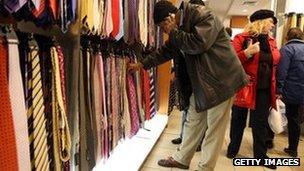US economy grows 2.5% on buoyant consumer spending
- Published

The US economy grew at an annual rate of 2.5% in the first three months of the year, helped by the strongest consumer spending figures in two years.
While the growth figure was lower than analysts' expectations, it was better than the 0.4% rate recorded in the final quarter of last year.
Consumer spending rose at an annualised rate of 3.2%, according to the Commerce Department data.
But government spending, especially on defence, fell at a rate of 4.1%.
'Sharp softening'
Consumer spending accounts for more than two-thirds of US economic activity, and the 3.2% rise during the first quarter is the fastest rate since the fourth quarter of 2010. It grew at a pace of 1.8% in the fourth quarter of last year. Home construction also rose further.
However, there is concern among economists that recent employment and retail sales data suggests spending is slowing. The larger-than-expected fall in government spending was one reason why the GDP came in below analysts' forecasts.
On 1 March, more than $85bn in mandatory government spending cuts, known as the sequester, began. The defence sector was due to bear the brunt of the cuts.
ING economist Rob Carnell said a breakdown of the figures showed "sharp softening" in growth as of March, indicating further weakening over April and May.
He said there was a good chance of the second quarter being "substantially weaker" with a "rogue negative quarter" even possible.
Maintain QE?
But Dan Greenhaus, managing director at BTIG, was hopeful of an improvement later in the year.
"We have observed some positives that suggest growth will pick up in the back half of the year, but the US economy still struggles to accelerate in a sustainable fashion,'' he said.
The figures could renew calls for the Federal Reserve to maintain its monetary stimulus programme of quantitative easing. The central bank meets next week and it is widely predicted that it will stick to its $85bn-a-month bond-buying schedule.
The GDP figures received a muted response on Wall Street, with the main Dow Jones index ending little changed, up just 12 points or 0.08% at 14,713.
The US economy has now grown for 15 consecutive quarters.
However, since the recession officially ended in June 2009 growth has remained weaker than usual after a downturn. The economy expanded by 2.4% in 2010, 1.8% in 2011 and 2.2% in 2012.
Analysts had hoped that this year would see a return to more robust growth of 3% or 4%.
But in comparison with other developed countries, the US is still performing relatively well.
In Europe in 2012, Germany's economy grew by 0.7%, the French economy was flat, while Italy's shrank by 2.4%.
In the UK, the economy grew 0.3% in the first quarter of 2013 from the final quarter of 2012. In the US the non-annualised quarter-on-quarter growth figure was 0.6%.